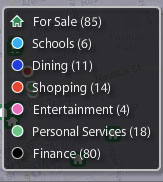New IDX and Lifestyle Search Engine gives brokers and agents an edge in their marketplace
(The following is an excerpt of an article about SpatialMatch written for a major online real estate magazine.)
 The real estate industry recently took a giant leap forward into the 21st century.
The real estate industry recently took a giant leap forward into the 21st century.
Real estate brokers and agents can now embed into their web sites a lifestyle search engine that contrasts an enormous database of neighborhood and area information against their MLS listing platform.
Essentially, an agent’s web site can provide all the relevant information a home buyer will need so they won’t have to go to enterprise-portal websites (i.e. Zillow, Trulia) to find it.
This revolutionary lifestyle-focused technology will generate more leads with higher quality, help home buyers choose a home more quickly, and impress sellers with innovation designed to sell their homes fast.
The map-based platform is called SpatialMatch® and was developed by two veterans of the online real estate industry, John Perkins and Grant Gould, founders of Home Junction® Inc.
“We could see the challenges that real estate agents were going to have in competing with the big real estate portals,” said Gould. “So we created this application that in essence, gives agents their own enterprise-portal search engine with all the hyper-local data that a home buyer wants.”
That information comes in the form of a search tool featuring billions of bits of neighborhood and area data. There are currently 104 layers covering 70+ million homes, 12+ million businesses and 130,000+ schools. Neighborhood amenity categories range from the “must haves” such as schools, restaurants, places of worship, airports, banks, golf courses, hotels, hospitals, etc. to the “interesting-to-know” such as bookstores, mini-golf, insurance agents, grocery stores, banks etc.
A local IDX provides MLS listings right inside this mountain of data, so buyers can find everything they need in one rich, real-time, and interactive search.
“Homebuyers today want data, data, and more data. Equally important is that they want control to personalize their search process. Lifestyle amenities are a huge part of that requirement,” said John Perkins, CEO of Home Junction. “People now want more than just a home. They want a home near the things they like to do, whether it’s exercising at the local gym or walking every day for an espresso at Starbucks. Savvy brokers and agents already understand this and are providing all of this data on their web sites to satisfy their users and keep them coming back.”
Interactive mapping had been the “rage” but is now becoming commonplace. The more interesting evolution is the real-time and simultaneous reviewing of dozens of datasets. How about visualizing thousands of listings on one screen and watch as they filter down to digestible numbers as users interact real-time with their search preferences? Or, users can deep-dive into rich datasets to uncover relevant and important information about their next neighborhood.
For example, with schools, buyers can understand the number and distribution of students, full time vs. part time teachers, student/teacher ratios and much more. Or how about the relationship between area demographics and for-sale housing? It’s all there.
Important boundary lines delineating properties, neighborhoods, school districts, zip codes, city and county limits are also available.
Users can explore new home construction complete with builders’ names, square footage, prices and in-depth information including floor plans.
Compressing this huge volume of data into a visually pleasing, user-friendly format was a challenge, Perkins said. Everything has to interact and align with everything else. Search results can be displayed as detail data or as “rolled-up” into area data. Places can be enveloped in color-coded circles determined by distance sliders. Icons separate the data into Homes, Lifestyle, Values, Areas and Favorites. Users can save their results and settings.
“One of the main goals we had when developing SpatialMatch® was to allow users to process through multiple huge datasets, in a real-time, and in a fun and entertaining user-friendly way. SpatialMatch® has exceeded those initial goals and we are now evolving the application to become even more impressive to the users and supportive to real estate professionals,” he said.
For a demo to see how this exciting new technology will help your real estate business, go here.
(Part Two next week will cover ways brokers and agents can use SpatialMatch to generate more business).

